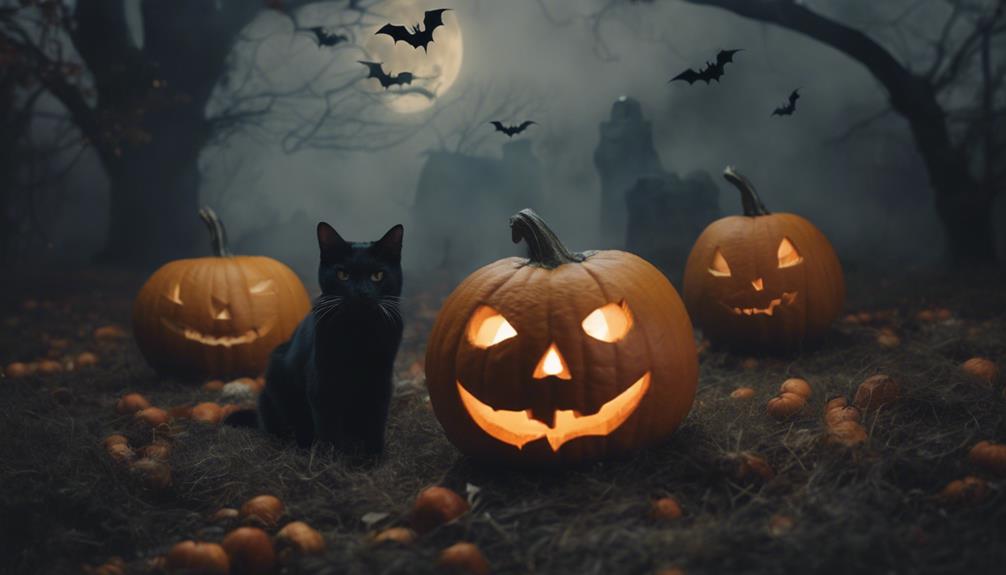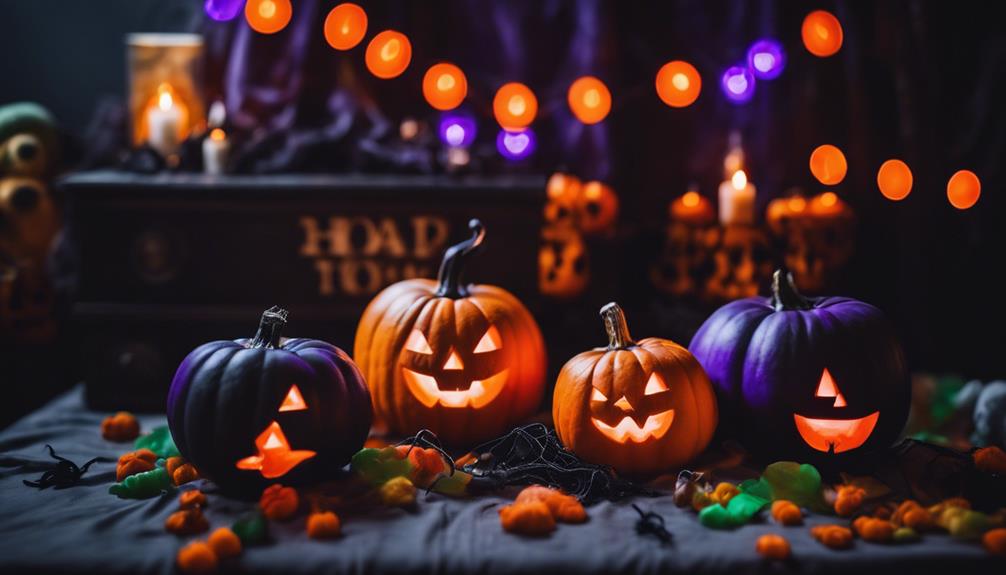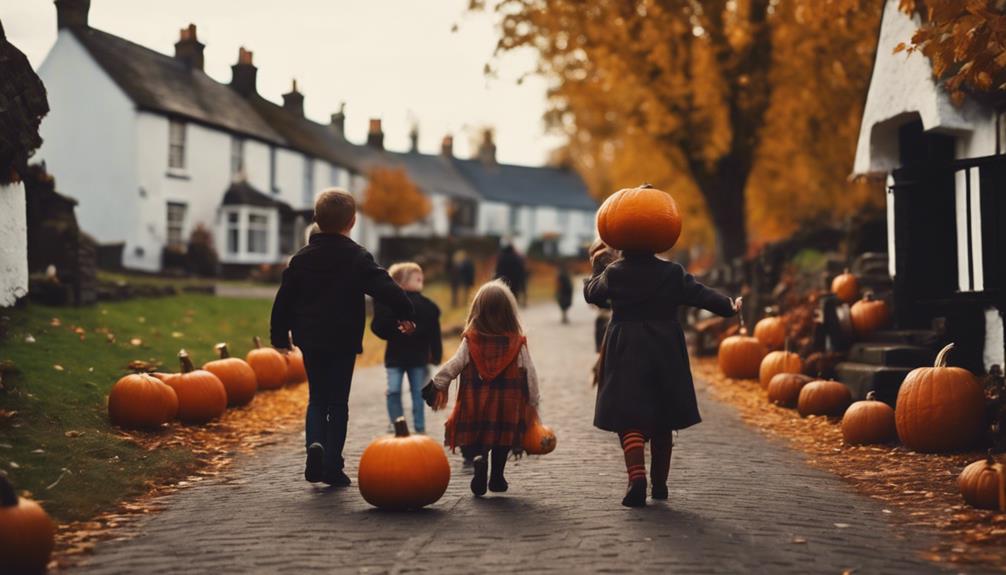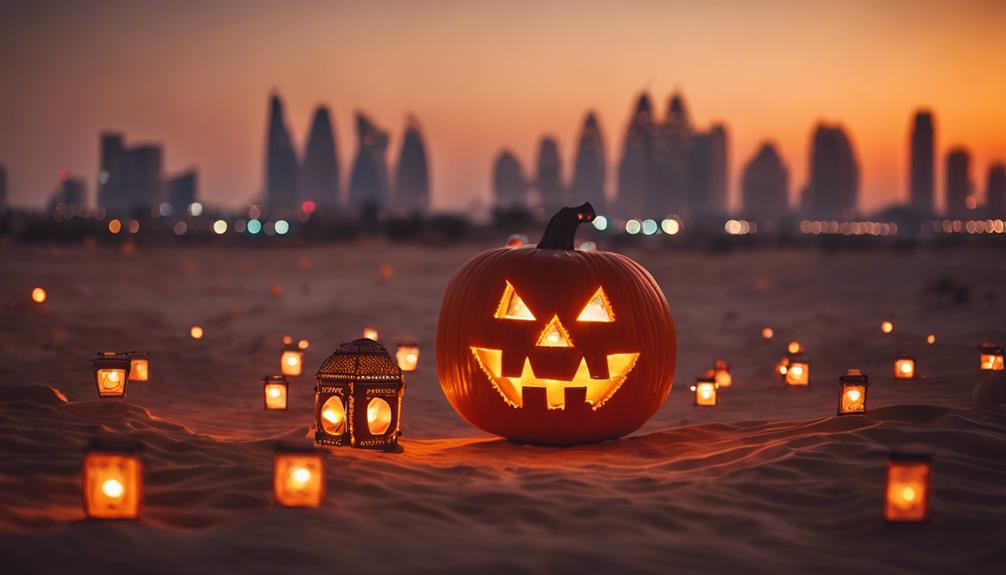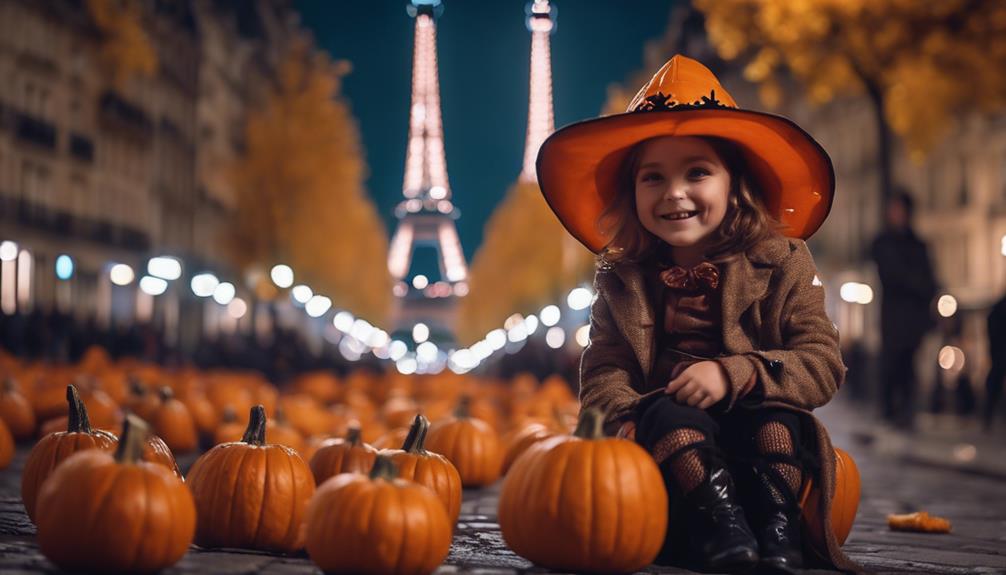Yes, Halloween has pagan origins. It traces back to the Celtic festival of Samhain, which marked the end of the harvest season and worshiped the deceased. Over time, the Christianization of Samhain transformed it into All Saints Day and All Hallows Eve, shaping Halloween into a Christianized version with Celtic roots. The modern Halloween customs and traditions we observe today are a blend of these ancient pagan and Christian practices. Discover more about the fascinating origins and evolution of Halloween and how it has intertwined both spiritual traditions into a unique cultural celebration.
Key Takeaways
- Halloween has pagan origins from the Celtic festival of Samhain.
- It blends ancient Celtic traditions with Christian practices.
- Symbols like jack-o-lanterns and costumes have pagan roots.
- Halloween reflects beliefs in the supernatural and honoring the dead.
- Samhain's influence is evident in Halloween's spooky themes and traditions.
Origins of Halloween
Halloween's origins trace back to the Gaelic festival of Samhain, signifying a significant shift in the Celtic calendar. This ancient festival marked the end of the Celtic year and the beginning of the dark half of the year. Samhain was a time when the Celtic people celebrated the end of the harvest season and honored the dead. It was believed that during this time, the boundary between the living and the dead was blurred, allowing spirits and ancestors to roam the earth.
The Christianization of Samhain began in Ireland after the 10th century. To integrate the pagan festival into Christian traditions, the Catholic Church adapted Samhain into All Saints Day and All Hallows Eve. This transformation eventually gave rise to Halloween as we understand it today. The festival's customs of leaving doors open and offering gifts to spirits were altered to pacify evil and welcome dead ancestors in a Christian context. Halloween represents the Christianized version of the ancient Celtic festival of Samhain.
Celtic Festival of Samhain
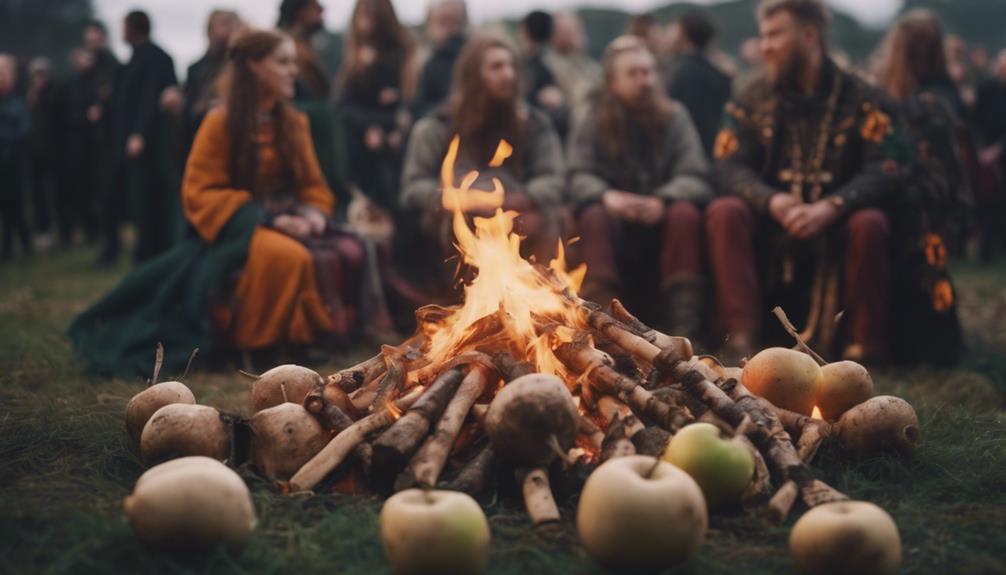
During the Celtic Festival of Samhain, ancient Celtic communities marked the shift to the dark half of the year with rituals honoring the deceased and celebrating the culmination of the harvest season.
Bonfires: The Celts lit sacred bonfires to ward off evil spirits and to provide light and warmth during the long, dark nights.
Offerings: They made offerings of food and drink to spirits and ancestors to seek their blessings for the winter ahead.
Spiritual Visibility: Believed to be a liminal time, Samhain was thought to be when the veil between the physical and spiritual worlds was thinnest, allowing interactions with spirits.
Open Doors: Doors were left open to welcome deceased loved ones and to allow spirits to pass through peacefully.
The Celts viewed this festival as a time of change and connection to the spiritual domain, where they paid homage to their ancestors and prepared for the challenges of the colder months.
Pagan Traditions and Symbols
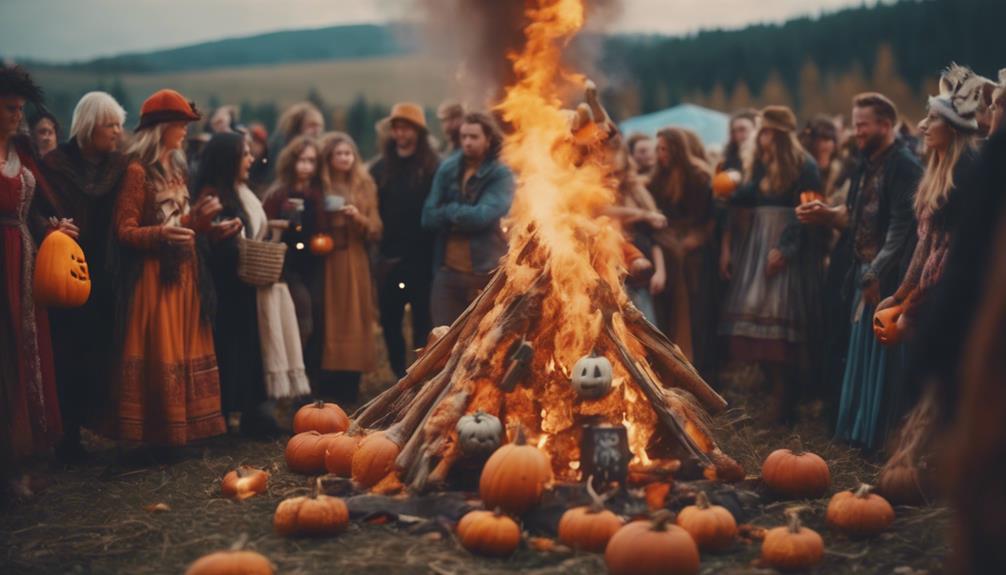
Pagan traditions and symbols, deeply rooted in ancient Celtic culture, play a significant role in shaping modern Halloween customs. The Celtic festival of Samhain, a pagan festival marking the end of the harvest season, is a key influence on Halloween as it's understood today. During Samhain, the Celts believed that the boundary between the living and the dead was blurred, leading to customs like honoring deceased loved ones and appeasing spirits for a prosperous year ahead.
Pagan symbols such as jack-o-lanterns, originally carved from turnips, and costumes worn to ward off evil spirits, have their origins in Celtic practices. Samhain rituals included community bonfires to ward off malevolent entities and offerings left out for spirits. These traditions have evolved over time but are still evident in modern Halloween celebrations, with activities like trick-or-treating and costume parties reflecting the ancient pagan festival's spirit of honoring the dead and embracing the supernatural.
Evolution Into Christian Holiday
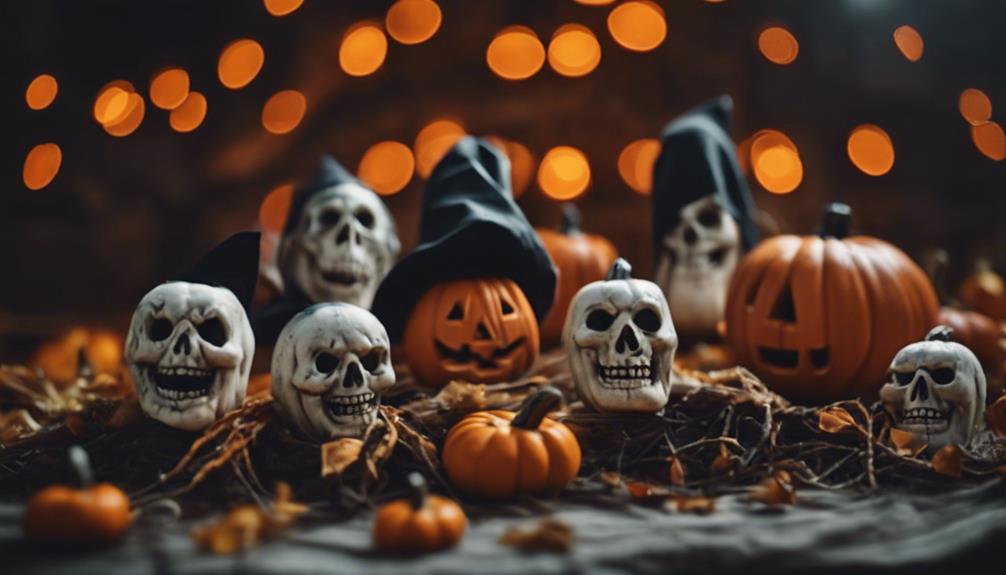
The conversion of the ancient Celtic festival of Samhain into a Christian holiday was initiated by the early Catholic Church through the adoption and adaptation of pagan traditions. This metamorphosis led to the creation of various Christian observances surrounding the original Celtic festival. Here are four key points to illustrate this evolution:
- The Catholic Church repurposed the Celtic festival of Samhain into the Christian holidays of All Saints Day and All Souls Day.
- The renaming of Samhain's eve to All Hallows Eve, later shortened to Halloween, symbolized the Christianization of the pagan festival.
- Halloween's association with the Christian calendar, particularly All Saints Day, solidified its shift from a pagan to a Christian holiday.
- The integration of Celtic customs into Christian practices played a significant role in shaping Halloween into a Christian celebration of saints and the deceased.
Through these adaptations, Halloween evolved from its pagan roots into a Christian holiday with a unique blend of traditions and beliefs.
Blend of Pagan and Christian Beliefs
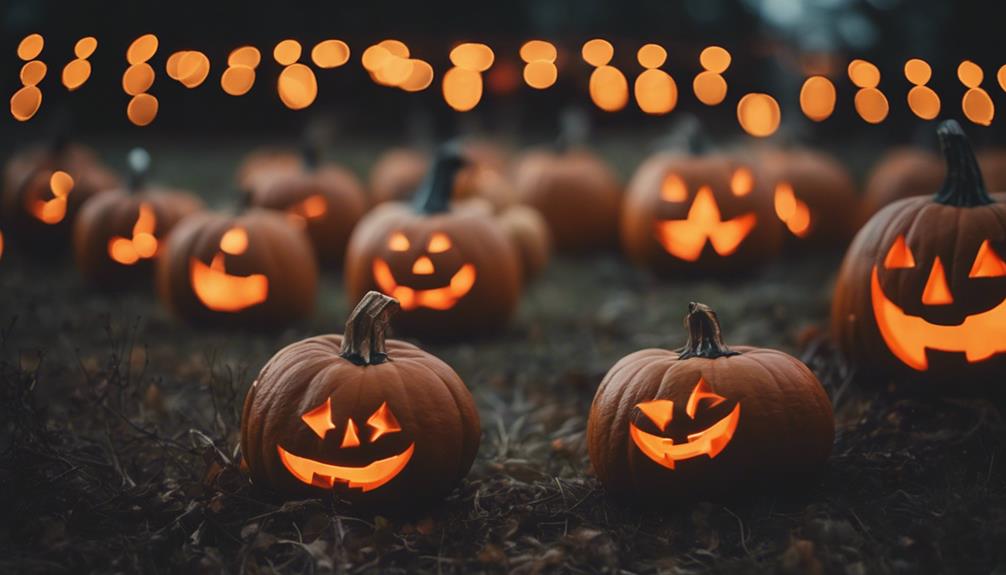
Blending pagan and Christian beliefs, Halloween has become a holiday that uniquely combines ancient traditions with Christian practices. The Catholic Church played a significant role in integrating these diverse elements into what we now know as Halloween.
The spooky symbols like ghosts and witches, which have pagan origins, became intertwined with Christian celebrations like All Saints Day. This blending of customs was particularly evident in the Christianization of the Celtic festival of Samhain.
All Hallows Eve, the precursor to Halloween, emerged as a result of this fusion of Celtic and Christian traditions, creating a holiday with a rich tapestry of cultural influences. The evolution of Halloween showcases how a mix of pagan and Christian beliefs can come together to form a festive occasion that resonates with people from various backgrounds.
This amalgamation of customs has given Halloween its distinct character, drawing from both ancient pagan practices and Christian observances.
Honoring the Dead in Halloween

Honoring the Dead in Halloween, deeply rooted in Celtic tradition, involves rituals that pay homage to deceased ancestors and mark the end of the harvest season. Here are four vivid aspects of how this ancient pagan Celtic holiday honors the dead:
- Offerings to Spirits: People would leave out food and drink as offerings to appease and honor the spirits of the departed.
- Open Doors: To welcome the souls of loved ones and ancestors back to the earthly domain, doors were left open during this sacred time.
- Pacifying Malevolent Entities: Belief in malevolent spirits roaming during Samhain led to leaving out treats to ensure protection from harmful entities.
- Spiritual Beliefs: Halloween's roots in honoring the dead reflect the profound spiritual and supernatural beliefs of the Celtic traditions during the festival of Samhain.
Samhain's Influence on Modern Halloween
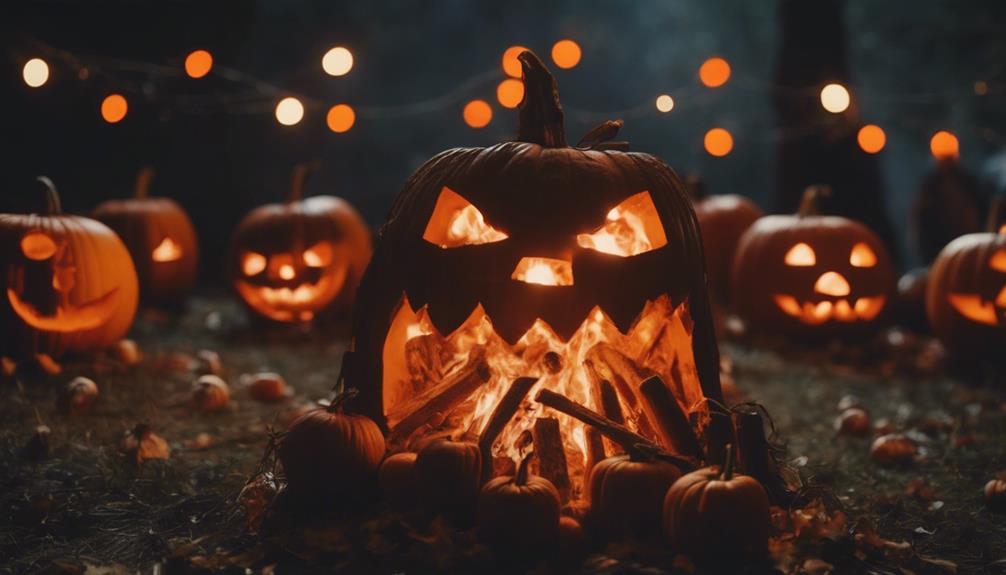
Drawing from ancient Celtic traditions, Samhain continues to exert a profound influence on the modern celebration of Halloween.
The Celtic festival of Samhain marked the end of the harvest season and the beginning of winter, a time when it was believed that the boundary between the living and spirit worlds was at its thinnest. This concept of spirits roaming the earth during Samhain inspired the Halloween belief in ghosts and supernatural beings.
The tradition of offering food and treats to pacify these evil spirits during Samhain evolved into the modern practice of trick-or-treating. Additionally, Samhain's association with the shift to the dark half of the year influenced Halloween's spooky themes and decorations.
Moreover, the Christian adaptation of Samhain into All Hallows Eve played a significant role in shaping the evolution of Halloween into the holiday we're familiar with today. So, when you carve pumpkins, dress up in costumes, and go trick-or-treating, you're participating in a celebration that has deep roots in ancient Celtic practices and Christian traditions.
The Dark History of Halloween

The dark history of Halloween stems from its pagan origins, where ancient Celtic traditions intertwined with Christian practices to create the holiday as it's recognized today. The merging of these two distinct belief systems gave rise to the Halloween as it's understood today, with its roots going back to the Celtic festival of Samhain. Here are four key aspects that contribute to the dark history of Halloween:
- Celtic peoples: The Celts celebrated Samhain as the end of the year, a time when the veil between the living and the dead was believed to be at its thinnest.
- Christian church: The Christian church later repurposed Samhain into All Hallows Eve, blending the pagan festival with Christian traditions.
- Samhain rituals: The Celts engaged in rituals to honor the deceased, leaving doors open for spirits, offering protection for the harvest, and lighting fires to ward off evil spirits.
- Integration of traditions: The integration of Celtic practices with Christian beliefs laid the foundation for the modern celebration of Halloween, with its focus on ghosts, costumes, and trick-or-treating.
The Role of Bonfires in Halloween
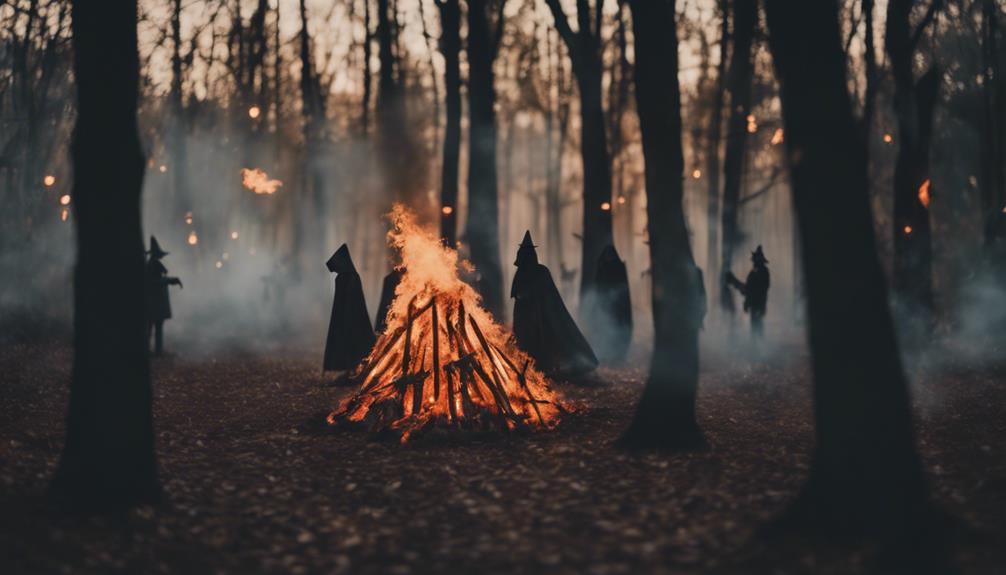
During ancient Celtic Samhain celebrations, bonfires held a significant role in warding off evil spirits and symbolizing the sun's protective power against darkness. The Celts believed that these bonfires had the power to protect their communities from malevolent forces during this time of year. Communities would gather around these roaring flames, seeking safety and comfort in their warm glow as they believed the fires would drive away any lurking spirits of the dead. The act of lighting bonfires wasn't just a practical measure but a deeply spiritual one, representing the eternal battle between light and darkness.
These ancient Celtic traditions of lighting bonfires during Samhain also involved rituals, sacrifices, and offerings to honor deceased ancestors. The flames were seen as a way to communicate with the spiritual plane and show respect for those who'd passed on. The legacy of these bonfires during Samhain continues to influence modern Halloween customs, connecting us to our ancient roots and the enduring symbolism of light triumphing over darkness.
Spiritual Significance of Costumes
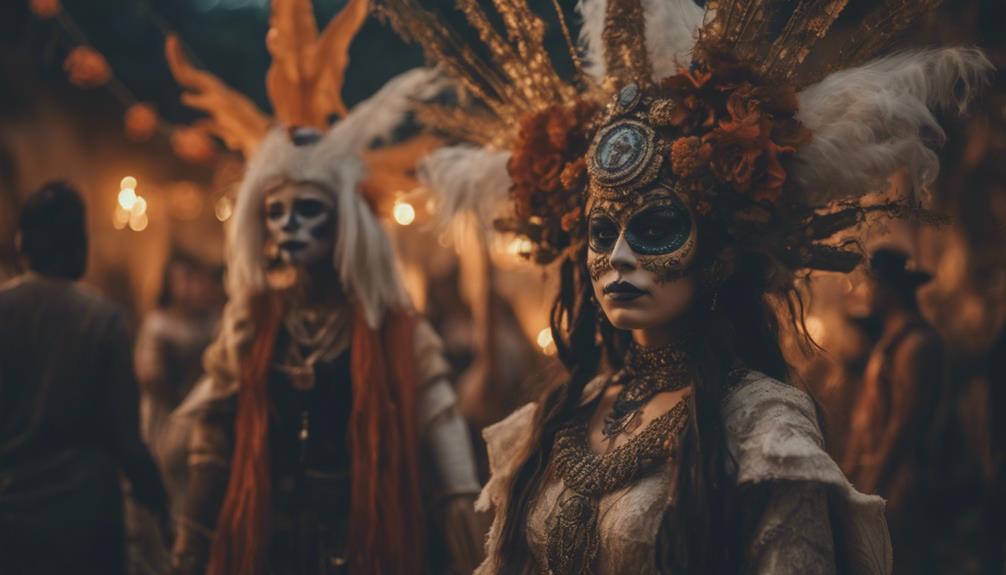
Costumes hold deep spiritual significance during Halloween, embodying ancient traditions of protection and disguise against malevolent spirits. By donning costumes, individuals express different aspects of themselves and connect with age-old practices of warding off evil energies.
This tradition allows for a transformative experience, fostering a sense of connection with the spiritual domain and honoring the thinning veil between the living and the dead.
Costume Symbolism and Meaning
Embodying a disguise through Halloween attire holds a profound spiritual significance rooted in ancient beliefs of blending with wandering spirits. When you dress up in a costume for Halloween, you're participating in a tradition that dates back to Celtic practices of disguising oneself to evade malevolent spirits.
Here are four ways in which costume symbolism and meaning play a role in Halloween traditions:
- Disguising: By wearing costumes, you're concealing your true identity, mimicking the act of hiding from spirits during Samhain.
- Blending In: The act of dressing up allows you to blend in with the spirits that are said to roam the earth during this time, offering protection from their malevolent intentions.
- Warding Off Evil: Costumes serve as a form of protection, deterring evil entities by appearing similar to them.
- Cultural Roots: The origins of Halloween costumes can be traced back to ancient Celtic rituals, where masks were worn to confuse and escape spirits.
Expressing Inner Selves
Exploring the spiritual significance of costumes during Halloween, you can plumb into the depths of your inner self through the art of disguise. Costumes have a long history in Halloween traditions, with roots that can be traced back to Catholic origins. When you don a costume, you have the opportunity to embody different aspects of your spiritual identity. Whether you choose to dress as a saint, angel, or mythical creature, your costume can reflect your personal connection to these symbols and convey deeper meanings about your beliefs and values.
Expressing your inner self through costumes allows for a form of self-expression that goes beyond mere outward appearance. It enables you to explore and showcase different facets of your personality, beliefs, and cultural influences. The choice of costume holds personal significance, serving as a powerful tool for introspection and creative expression.
Connecting With Traditions
Delving into the spiritual significance of Halloween costumes reveals a profound connection to ancestral traditions and mythical beings. When you put on a costume during Halloween, you aren't just disguising yourself; you're stepping into a domain where the ancient Celts believed the veil between the living and the dead was thinnest. Here's how costumes can deepen your spiritual experience:
- Ancestral Homage: By dressing up as characters from folklore or history, you pay homage to the spirits of your ancestors.
- Transformation Symbolism: Wearing a costume can symbolize a transformation, allowing you to embody different identities or archetypes.
- Warding Off Evil: Some see costumes as a way to ward off evil spirits, protecting themselves and their loved ones.
- Ritualistic Expression: Costumes serve as a form of ritualistic expression, connecting you to the spiritual domain and the traditions that have been passed down through generations.
Through costumes, you can tap into the spiritual significance of Halloween, honoring ancient traditions while connecting with the mystical essence of the holiday.
Frequently Asked Questions
Can Christians Celebrate Halloween?
Yes, as a Christian, you can celebrate Halloween. Many Christians focus on the Christian aspects of the holiday, like the vigil before All Saints Day. It's an opportunity to educate kids about the origins of All Saints Day and honor holy figures by dressing up as saints.
Parishes often organize events where children can learn about the Christian significance of Halloween. It can be a fun way to lead into the solemnity of All Saints Day.
What Religion Is Halloween Holiday?
Halloween is a holiday with Christian roots, originally tied to All Saints Day. It has evolved over time to include various customs like dressing up in costumes and going trick-or-treating.
While some may associate Halloween with paganism, its origins are more closely tied to Christian traditions. So, in short, Halloween is primarily a Christian holiday with modern-day customs that have become popular across different cultures and beliefs.
Why Don't Catholics Celebrate Halloween?
Catholics celebrate Halloween, viewing it as the Evening Vigil of All Saints Day. It's an opportunity to honor saints and educate about Catholic origins. Some Catholics may avoid certain customs due to perceived pagan influences.
Children dressing as saints aligns with the Christian significance of the day. Parishes host events for kids to dress as saints, merging Halloween with Christian traditions.
Is Easter Really a Pagan Holiday?
Easter, despite some pagan roots, mainly commemorates the resurrection of Jesus Christ in the Christian faith.
The holiday's timing near the spring equinox and certain customs like the Easter bunny have pagan origins but were incorporated to ease conversions from pagan traditions to Christianity.
While Easter has absorbed some elements, its core significance remains tied to the religious belief in Jesus' resurrection, distinguishing it as a Christian holiday.
Conclusion
To sum up, the origins of Halloween are deeply intertwined with pagan traditions, especially the Celtic festival of Samhain. While it has transformed into a Christian holiday over time, the influence of its pagan roots can still be seen in modern celebrations.
From bonfires to costumes, the spiritual significance of Halloween continues to fascinate and enchant people worldwide. So the next time you don a costume or gather around a bonfire, recall the ancient origins of this eerie holiday.
